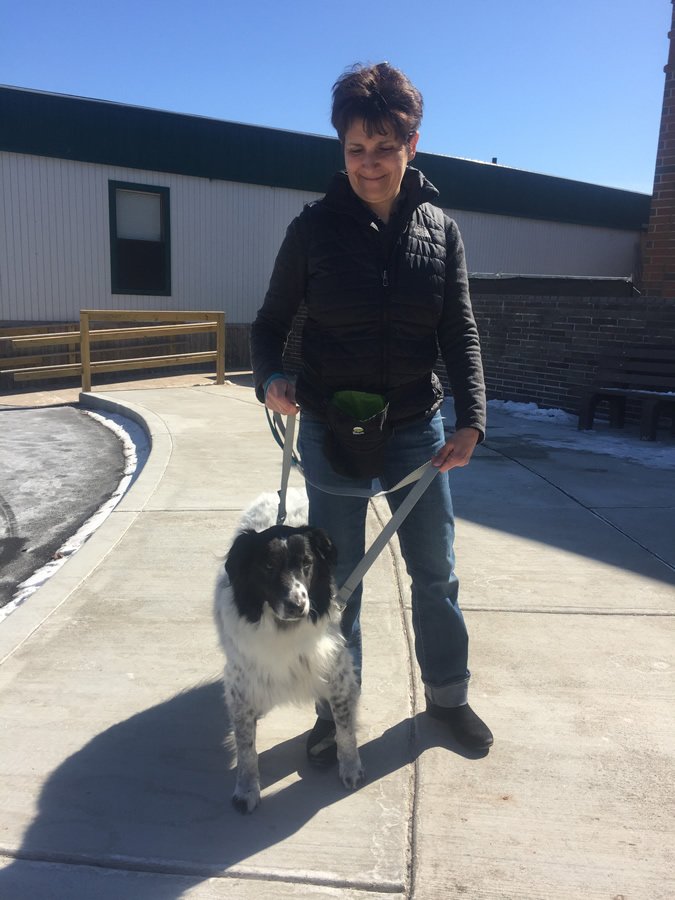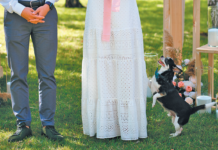Rita Denton of Jefferson City, Missouri, is beside herself. Her daughter’s French bulldog attacks “anything that moves,” she says — “big dogs, carriage horses, police on bicycles, children. I am afraid,” Ms. Denton comments, “my daughter will end up with a lawsuit on her hands!”
Her daughter has tried everything to attenuate the dog’s chasing/herding behavior — special harnesses, water bottle sprays, verbal commands. One trainer even suggested using a shock collar (a form of punishment that we are very much against as it only teaches a dog to fear and distrust her owner rather than teaching what to do in place of the unwanted behavior).
Tufts Animal Behavior Clinic head Stephanie Borns-Weil, DVM, isn’t surprised that a bulldog would be prone to chasing down moving things — or people. “The French bulldog has a high prey drive,” she says. The reason may lie in its heritage. It is thought that the breed was developed in the 1800s from the English bulldog and French ratters (small terriers bred to catch rats). “Virtually all dogs have a prey drive,” she is quick to note, “but some, like terriers, have it more than others.” And they’re not going to be coaxed away from that drive terribly easily.
True, most dogs become socialized enough in the world of people that after a while, especially on leash, they come to know when to act on their instincts and when to remain calm — because they recognize that the potential moving target is not really prey. But Dr. Borns-Weil suspects that perhaps the dog in question isn’t coming around because it’s fear rather than a high prey drive that’s driving his behavior — or maybe a combination of the two. But either way, whether predatory instinct or fear, the solution has a number of shared elements.
A better harness — and avoiding the wrong situations — is in order
When it comes to dogs attacking people, especially children, and other animals, the first order of the day is safety, which includes avoiding (at least at first) busy areas with carriage horses, crowds, and the like. This is especially important for a dog with fear issues. Flooding him with situations that scare him and cause him to act aggressively is not going to desensitize him; it’s only going to sensitize him further. He needs to gradually work up to situations that currently scare him with staged meet-ups with people and other animals that happen in very controlled settings arranged by you.
And whether the dog is afraid or highly predatory (or both), using a harness that doesn’t allow the dog to lunge at others despite being connected to you by the leash is absolutely critical. You need to have very firm control and the ability to quickly turn the dog away from any danger he might pose.
There are a number of harnesses that will do the trick. “My favorite,” Dr. Borns-Weil says, “is the Freedom No-Pull Harness with the double-handled leash. Another good harness with a double-handled leash is made by Company of Animals.”
These harnesses are very operator-sensitive and provide excellent control, allowing you to rapidly turn a dog’s face way from the person or animal he is after. They also allow for teachable moments. Teaching a dog not to attack moving objects or beings can start only with a leash. There will be no controlling him off leash until he is very well controlled on leash. These teachable moments can be described in three steps.
- When the dog passes a potential trigger and does not react (which is sure to happen at least sometimes; otherwise the pet would be in a constant state of lunging and chasing), reward him by telling him what a fabulous dog he is and giving him a nice treat. After all, Dr. Borns-Weil says, “he did something — he behaved appropriately. Maybe it was only because you were 30 feet from the carriage horse, but the aim is to capture those opportunities to reward the behavior you want when it occurs.”
- When your dog does start to go after something or someone he shouldn’t, firmly and even handedly (not angrily) tell him, “Leave it.” It’s your chance to tell him what to do instead of trying to get him not to do something in the middle of the act. If he does in fact “leave it,” even if he’s 20 feet away from whatever he was going after, of course immediately let him know how proud of him you are and reward him as you move him away from the trigger.
- If number 2 doesn’t work out — he continues to go after what he shouldn’t (and this is going to happen a lot, especially at first) — physically help him. “This is where it gets tricky because it’s when people start yelling at their dog, which you shouldn’t do,” Dr. Borns-Weil says. It’ll just serve as a mistaken signal to the dog that you, too, are agitated by the same thing he is.
Instead, she advises, step up close to your dog, touching him with your leg. Right away, hold the leash attached to his back with your hand on his side, and hold the leash attached to his chest (remember, it’s double handled) with your hand on the other side of him. Then pivot away from the trigger until his back is to it — out of sight, out of mind. Follow through by walking away and praising and rewarding him, even though you helped him behave correctly. “It’s right for you to step up and indicate what the appropriate behavior is when he’s doing something that’s not okay,” Dr. Borns-Weil says. The message to your dog will be: ‘ignore and avoid. That will make the the problem go away, and you will find it rewarding.’
What Dr. Borns-Weil particularly likes about this method is that it allows you to teach your dog what’s appropriate without causing him pain and distress. Even though you’re moving quickly, you’re gently and smoothly turning your dog away from the problem. With the right harness, your dog will not flip and flop, trying to resist you.
Going from practicing on leash to off
You must get the dog to comply readily on leash before trying to get him to follow your cue to keep from chasing after things when he’s off the leash, Dr. Borns-Weil says. Will you ever be able to get to that point? Often, yes. Many dogs who are big chasers even learn to run to their owners for a reward/treat when they see a person or another animal running by instead of going after the moving target. But not all dogs get there. Some have too much of a predatory drive, or herding instinct, or fear, to keep them capable of heeding your cue in a hot and heady moment. So what do you do then?
It’s easy, but ever so important: you forever keep your dog on leash in situations where he might get himself (and you) into trouble. Save off-leash for romps in the woods where he won’t be burdened by the rules of human civilization. Dogs are always going to be dogs. They work very hard to accommodate themselves to the world of people, but it’s not always going to be a perfect fit, and it’s nobody’s fault — neither the dog’s nor yours.
If you do not live near any secluded spots that your canine pal can run off leash, we strongly suggest you sign him up for structured activities during which he’ll be able to scratch his genetic itch, so to speak. As Dr. Borns-Weil puts it, “they’ve got to be able to do what they’re biologically programmed to do. Otherwise, they’re going to frustrate their owners and be an unhappy dog.”

For a predatory dog, you can try flyball classes, or lure or earth dog courses. With flyball, a dog is part of a four-dog team that relays a ball to each other as they jump over hurdles. It goes very fast, with each owner racing her dog through as fast as possible so that in catching balls (the prey), the dog finds himself in a fun frenzy of running, jumping, and getting his mouth around the desired object.
Lure courses, though intended primarily for sight hounds with high predatory instincts, can help any dog with a high prey drive go in for the “kill.” In a fenced-in area, a plastic bag is attached to a machine, and the dog is let off leash to track the bag as it’s pulled along a long line, zigzagging like prey trying to escape.
Earth dog courses are meant, for the most part, for small terriers and some hounds. A course can range from a simple 10-foot tunnel to a considerably longer one with twists and turns. Every course has an odor strewn along its path, eventually leading the dog down a hole to a mock den in the ground that’s harboring whatever he’s smelling (perhaps a rat in a cage that the dog can sniff and see but not touch). A lot of digging — and barking — tends to ensue.
Some predatory dogs also very much enjoy agility courses, Dr. Borns-Weil says. “It requires intense communication between owner and dog, which is what they’re bred for,” she explains. Prehistorically, predatory dogs helped people hunt for food — that they then both ate.
If it’s not a predatory itch that’s driving your dog but a herding instinct (the two can look similar, but herding dogs are simply trying to get other animals to gather where they want, not hunt them), herding classes will really help him relieve his urge. Different herding breeds were bred to rein in different livestock — corgis for cattle, for instance, and briards for sheep. If you live reasonably close to a rural or even semi-rural area, you can usually find a class to suit your particular dog. In some places you can even sign up your pet to herd geese.
There’s a class for almost every dog with every kind of built-in propensity — courses where water-loving dogs have to jump into the water and retrieve floating objects, Frisbee competitions to catch moving objects hurling through the air, even opportunities for tracking, say, a glove placed somewhere along a trail.
Think of these classes as fulfilling the same need for dogs that competitive team sports fulfill for people, Dr. Borns-Weil says. “Humans are tribal, turf-defending,” she points out. “But Tufts doesn’t need to go to war with another school. That’s why we have football teams. It’s a safe outlet that allows us to do what we’ve been genetically selected to do, but in keeping with modern life.
“You still need to train a dog not to run after a car,” she says. But if he’s not frustrated because he has opportunities to act on his instincts, he’ll feel more satisfied, more tired after a good workout, and more bonded to you for the good care you take to meet his needs, all of which will help attenuate his proclivity to give into his nature at inappropriate times.
Will it work completely? Perhaps not. “You can’t have unrealistic expectations,” Dr. Borns-Weil says. Even people don’t always get it right. We get into wars or smaller altercations sometimes, letting our more problematic instincts take over. But if you supply a dog with the very high physical and mental stimulation he needs, you have a much better chance of living with a well-behaved pet.





